† Corresponding author. E-mail:
Ultraviolet (UV) photodetectors have attracted more and more attention due to their great potential applications in missile tracking, flame detecting, pollution monitoring, ozone layer monitoring, and so on. Owing to the special characteristics of large bandgap, solution processable, low cost, environmentally friendly, etc., wide bandgap oxide semiconductor materials, such as ZnO, ZnMgO, Ga2O3, TiO2, and NiO, have gradually become a series of star materials in the field of semiconductor UV detection. In this paper, a review is presented on the development of UV photodetectors based on wide bandgap oxide semiconductor films.
In recent years, ultraviolet (UV) photodetectors have gained extensive attention of researchers worldwide owing to their potential applications in solar UV radiation detection, missile tracking, flame detection, ozone monitoring, environmental monitoring, etc.[1–4] Although GaN and SiC based UV photodetectors possess mature manufacturing technologies and thus have already been commercialized,[5–7] it is still tough to further reduce the cost and improve the performance for wide applications. Wide bandgap oxide semiconductors, including ZnO, ZnMgO, Ga2O3, TiO2, NiO, and so on, are the focus of current research efforts since they have special physical and chemistry properties, such as stability, environmental friendliness, and enrichment of raw materials.[8–12] Till now, the UV photodetectors based on wide bandgap oxide semiconductors with various device structures have been demonstrated, including p–n junction, Schottky junction, metal–semiconductor–metal (MSM) structure, and heterojunction. Several review articles have been published on ZnO-based UV photodetectors and metal–oxide nanostructure photodetectors.[13–17] Liu et al. summarized the history and the development of ZnO-based photodetectors.[13] Hou et al.[14] and Yang et al.[15] focused on the performances of ZnO-based UV photodetectors and the relevant physics. Zhai et al.[16] and Tian et al.[17] discussed several kinds of important metal–oxide nanostructures (such as ZnO, SnO2, Ga2O3, Cu2O, Fe2O3, In2O3, CdO, CeO2, Nb2O5, and WO3) and their corresponding photodetector applications.
In this review, we will first discuss the technical development of ZnO-based UV photodetectors, followed by recent advances of UV photodetectors based on Ga2O3, TiO2, and NiO. Finally, a brief summary, challenge, and prospect will be given.
ZnO is one of the most prominent members of the family of wide bandgap oxide semiconductor due to its unique physical and chemical properties.[18–20] It has strong radiation hardness, high chemical stability, low cost, and a large bandgap of 3.37 eV at room temperature.[21–23] Furthermore, by alloying ZnO with MgO, the bandgap of ZnxMg1−xO can be adjusted from 3.37 eV to 7.8 eV,[24,25] which is essential to fabricate UV photodetectors with different cut-off wavelengths. These properties are crucial for practical optoelectronic devices used in missile warning system, flame detection, and inter-satellite communications.[26–28] In addition, ZnO and its alloy ZnMgO materials are environment-friendly and rich in natural resources. Therefore, ZnO-based material is one of the best candidate materials for preparing UV photodetectors.[29–33]
After years of development, UV photodetectors based on ZnO and ZnMgO films have made great process, which has been discussed in the previous reviews.[13–15] Notably, to improve the performance of ZnO-based UV photodetectors, various methods have been selected, such as surface treatment, surface plasmonic effect, mixed-phase material, and so on. In this section, we will describe several ways to improve the performance of ZnO-based photodetectors.
According to previous reports, ZnO exhibited a strong adsorption/desorption behavior of oxygen on the surface, which had a very big influence on the properties of ZnO-based UV photodetectors.[34,35] For example, these adsorption/desorption processes of oxygen on the surface of ZnO could lead to a long rise/decay time of bare ZnO-based UV photodetectors.[36,37] In order to improve the performance of ZnO-based UV detectors, scientists have studied many methods, such as oxygen plasma treatment,[38–41] surface passivation,[35,39,42] solution treatment,[43–45] and so on. In 2003, Coppa et al.[38] cleaned the ZnO (000-1) surface by O2/He plasma, which could significantly improve the rectifying characteristics of Au/ZnO junction. Liu et al.[46] treated the ultrathin (20-nm-thick) ZnO epitaxial films with oxygen-radical-rich inductively coupled plasma to improve the performance of detectors (the decay time was reduced to below 50 
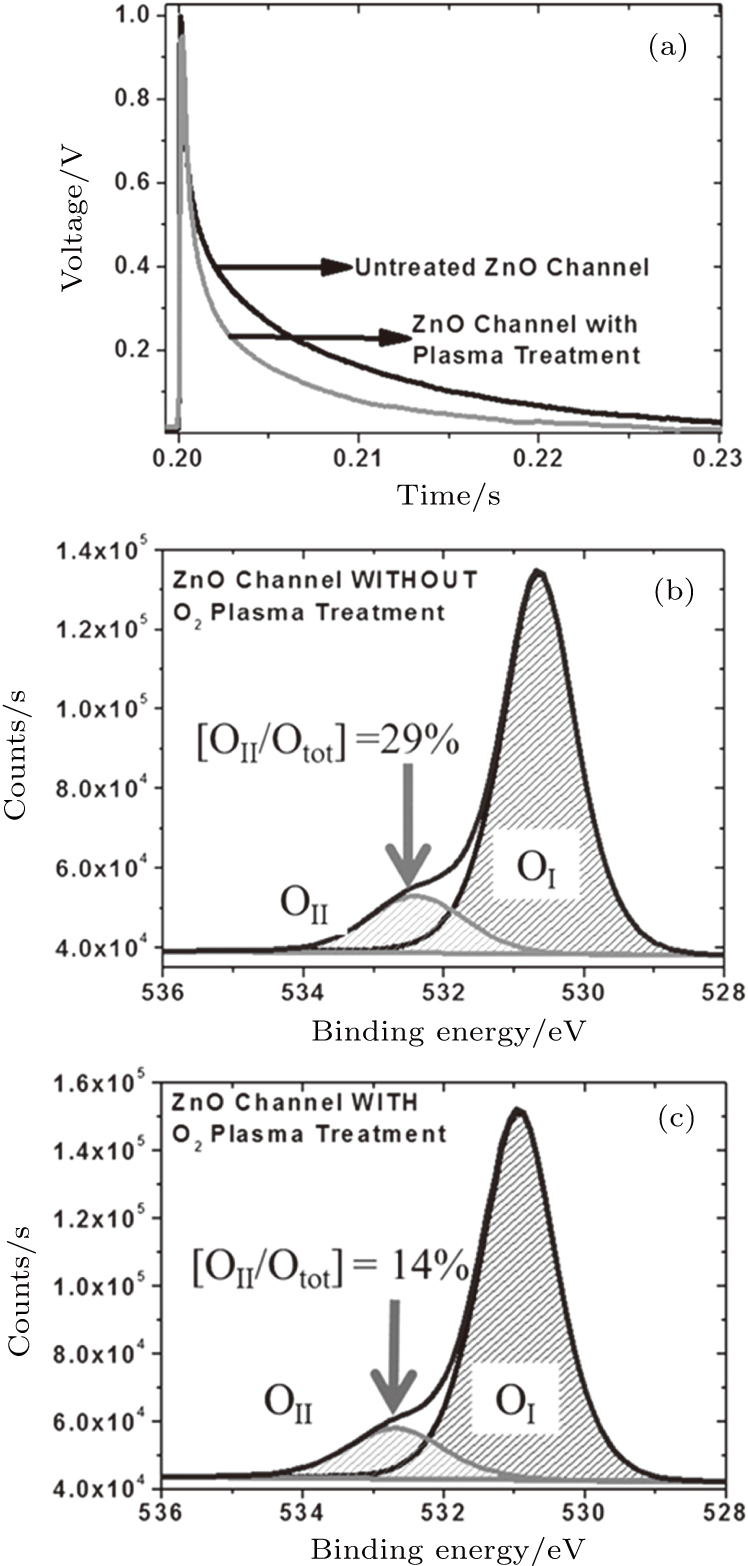 | Fig. 1. (a) Recovery times of the ZnO-TFT UV photodetector with and without channel surface treatment; XPS spectra of (b) untreated ZnO channel, and (c) oxygen plasma-treated ZnO channel.[48] |
In addition to oxygen plasma, the surface treatment by solution is also a common method to improve the performance of ZnO-based photodetectors, and this method has been widely used in the devices based on ZnO micro/nanostructures.[49–52] Recently, scientists have introduced this method into ZnO thin film detectors. In 2017, Zhu et al.[36] investigated the effect of H2O2 solution treatment on the properties of the ZnMgO thin film and its UV photodetectors. After the treatment by H2O2 solution, the dark current of ZnMgO UV photodetectors decreased by more than one order of magnitude. Moreover, the response time of the device could be significantly reduced both in vacuum and an oxygen atmosphere by H2O2 solution treatment due to the reduction in the oxygen vacancy defects in ZnMgO. However, the responsivity would also be obviously decreased using this method.
More recently, Chen et al.[37] demonstrated a performance enhancement of ZnMgO photodetectors through HF solution treatment. As shown in Fig.
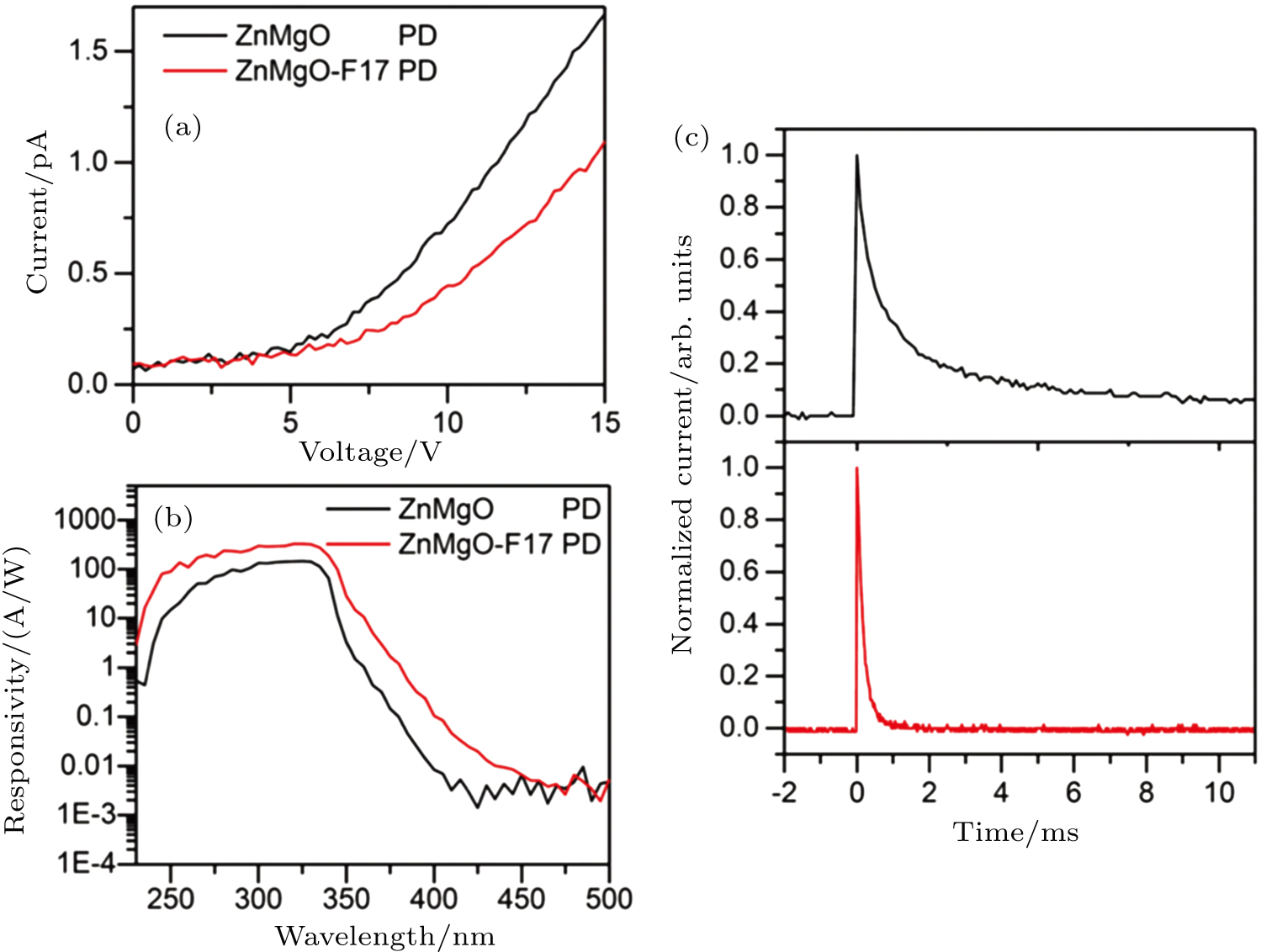 | Fig. 2. (a) I–V characteristics of devices in the dark. (b) Spectral responses of the devices under a bias of 10 V. (c) Decay edge of the current response at a bias of 10 V.[37] |
Surface plasmons (SPs) are collective oscillations of free electrons between metal and dielectric (semiconductor) materials, which have also been employed to enhance the performance of photodetectors.[53–64]
In 2014, Tian et al.[56] reported that Pt nanoparticles could be used to enhance the performance of the UV photodetectors, where surface plasma resonance occurs. Figure
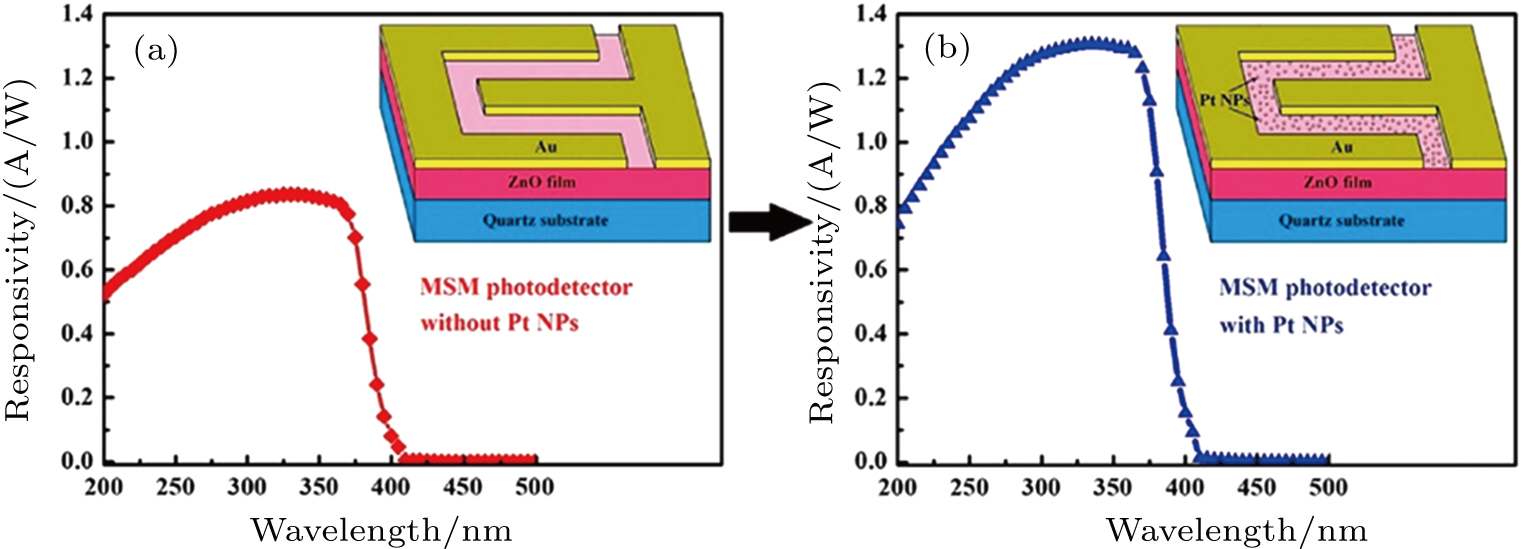 | Fig. 3. Response spectra of the ZnO MSM structure UV photodetectors before and after sputtering of Pt nanoparticles. The inset shows the schematic illustration of the device.[56] |
Compared to the traditional dipole plasmon resonance, high-order plasmon modes are often excited in the shorter-wavelength range, which is expected to be used to improve the UV-detection performance. Moreover, a highly wavelength-selective UV response enhancement for ZnO photodetectors could be achieved due to the narrow-band quadrupole resonance. In 2017, Ag nanoparticles-decorated ZnO photodetectors were proposed by Wang et al.,[62] and the device exhibited an obvious increase in peak responsivity at around 380 nm, which could be attributed to the narrow-band quadrupole plasmon resonance of Ag nanoparticles in the UV range. Figure
 | Fig. 4. (a) J–V characteristics in dark condition and (b) response spectra of the ZnO UV photodetectors with and without Ag nanoparticles under 15-V bias. (c) Time-dependent photocurrent with periodic switching of UV illumination (380 nm) measured at 30-V bias.[62] |
In brief, the performance of ZnO-based photodetector has been significantly improved by introducing metal plasmon resonance, and these results could provide a promising way to develop high-performance UV photodetectors.
As is well known, ZnO is stabilized in the hexagonal wurtzite structure, while MgO is stabilized in the cubic rock salt structure. Therefore, the crystal structure of ZnMgO alloy would change from wurtzite structure to cubic structure as the Mg content increases. And ZnMgO with both hexagonal and cubic phases is commonly obtained in the previous reports, which could be called mixed-phase ZnMgO. It could be found that the photodetectors fabricated on mixed-phase ZnMgO exhibit a relatively higher responsivity than that of the single-phase devices.[31,65,66] Thus, preparing mixed-phase material may be a viable method to improve the performance of ZnMgO UV photodetectors. However, the mixed-phase ZnMgO usually has two absorption edges: one is shorter than 280 nm and the other is longer than 300 nm, indicating that they are not suitable for solar-blind detection without external filters.[18,67–70]
In 2014, a mixed-phase Zn0.38Mg0.62O film with a single absorption edge has been firstly deposited on a-face sapphire using plasma-assisted molecular beam epitaxy by Fan et al.[71] Furthermore, a mixed-phase ZnMgO UV photodetector with excellent comprehensive performance has been fabricated. The device showed only one response peak at 260 nm with the responsivity of 1.664 A/W which is different from other mixed-phase ZnMgO photodetectors containing two photoresponse bands. In addition, the dark current of the device was only 0.25 pA at 5 V, which was much lower than that of the reported mixed-phase ZnMgO photodetectors. After that, Fan et al. further studied the carrier transport process of mixed-phase ZnMgO photodetector at different conditions, such as thermal equilibrium, dark, and UV illumination, as shown in Fig.
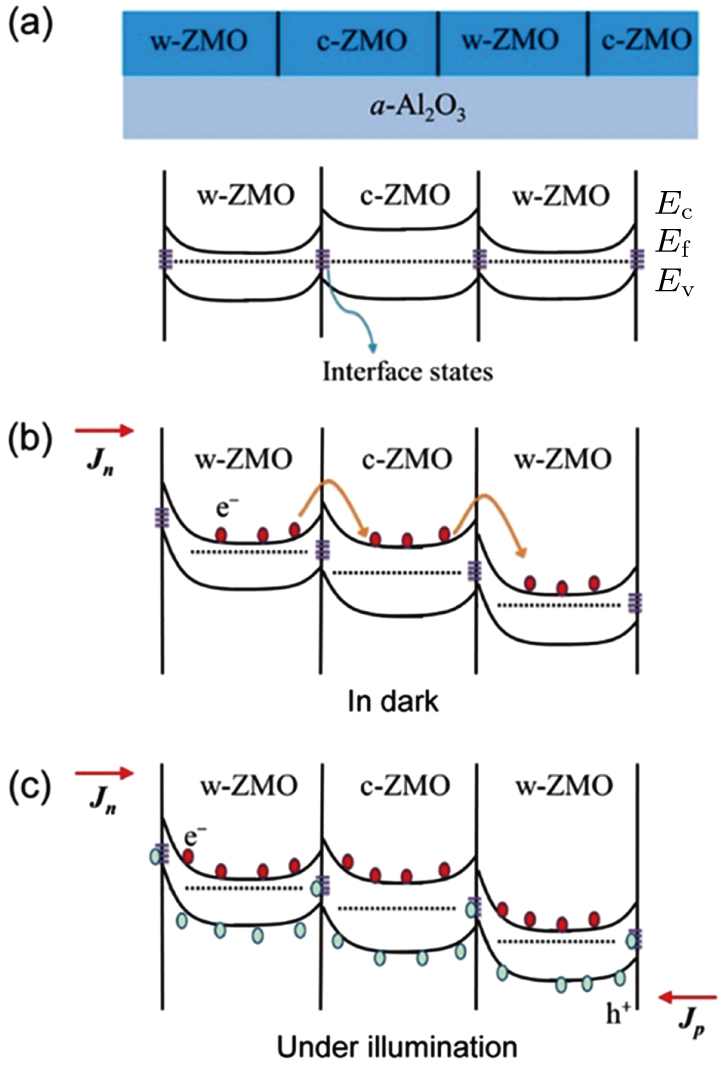 | Fig. 5. Energy band diagram and carrier transport process of mixed-phase ZnMgO photodetector at different conditions: (a) at thermal equilibrium, (b) under bias in dark, and (c) under bias with UV illumination.[72] |
In addition, several other methods have been used to improve the performance of ZnO-based UV photodetectors.[76–85] For example, Tian et al. and Wang et al.[82,83] developed the high performance ZnO nanosheet field-effect transistor by using ferroelectric to get the very low dark current. The device reveals an improved optical response and detectivity up to 3.8×105 A/W and 4.4×1015 Jones (unit Jones: 
Due to space limitations, we only summarize the above methods used to improve the performance of ZnO UV photodetectors (PDs). Although ZnO-based UV photodetectors have made great progress in recent years, there are still some problems remaining to be solved. For example, the lack of stable and reproducible p-type ZnO-based materials, the low responsivity of MgZnO solar-blind PDs, the slow response speed, and so on. Therefore, more research should be performed to address these challenges.
Solar-blind UV photodetectors can accurately response to a very weak signal even under sun or room illumination. Monoclinic Ga2O3 (β-Ga2O3), with an intrinsic bandgap Eg of ∼4.9 eV and accordingly a corresponding wavelength of ∼260 nm,[86–91] is naturally suitable for solar-blind UV detection. Consequently, Ga2O3 has attracted much attention recently, and its characteristics of solar-blind UV detection have been demonstrated in various device structures, including MSM structure, Schottky junction, and heterojunction structure.[92–103]
MSM structure photodetectors have the advantages of simple structure, easy preparation, etc. In 2007, Kokubun et al.[104] grew β-Ga2O3 MSM photodetectors using sol–gel method, and the maximum responsivity of the device was only 8×10−5 A/W. In 2014, Guo et al.[105] deposited β-Ga2O3 epitaxial thin films using laser molecular beam epitaxy (L-MBE) technique, and in situ annealing on the film under oxygen atmosphere could lead to the transition of the Au/Ti electrode/β-Ga2O3 thin film from ohmic to Schottky contact due to the reduction of the oxygen vacancy. Figure
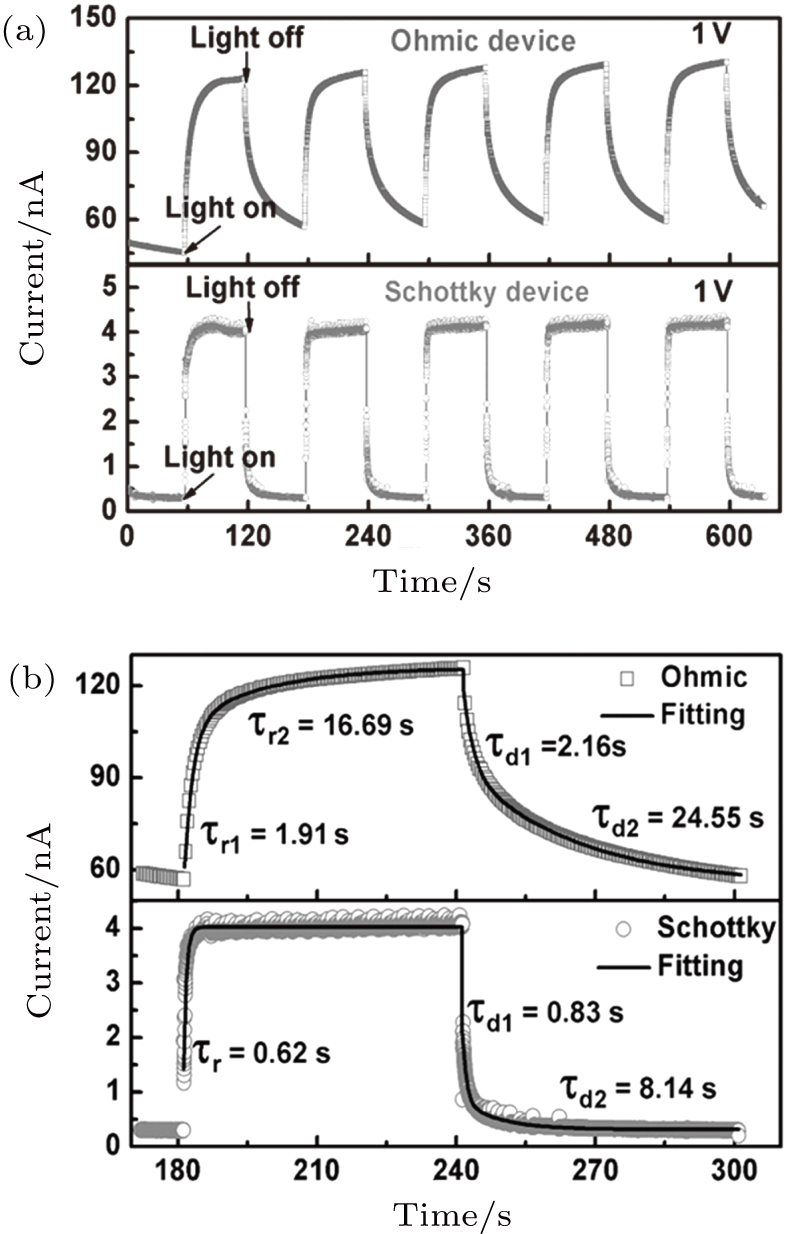 | Fig. 6. Time-dependent photoresponse of the β-Ga2O3 thin films prototype photodetector to 254-nm illumination: (a) the ohmic-type device and the Schottky-type device; (b) enlarged view of the rise/decay edges and the corresponding exponential fitting for the ohmic-type device and Schottky type devices, respectively.[105] |
In 2015, Hu et al.[106] deposited β-Ga2O3 film using metalorganic chemical vapor deposition (MOCVD) technique, and the photodetectors with interdigitated electrodes have been designed and fabricated on this film. The device exhibited a responsivity of 17 A/W, a UV-to-visible rejection ratio of 8.5 ×106, and a quantum efficiency of around 8228% at 20-V bias. In 2017, Alema et al.[107] reported the fabrication and characterization of solar-blind photodetectors based on undoped β-Ga2O3 and Zn-doped β-Ga2O3 (ZnGaO) epitaxial films with a cutoff wavelength of 260 nm. The ZnGaO detector showed a peak responsivity of 210 A/W at 232 nm, which is much higher than that for β-Ga2O3 device (46 A/W). In 2018, Zhang et al.[108] grew high quality β-Ga2O3 film by using N2O as reaction gas for the fabrication of high performance solar-blind photodetector. This device exhibited a high responsivity of 26.1 A/W. And the rise and decay times were around 0.48 s and 0.18 s at 10 V, respectively. The excellent performance can be attributed to the reduction of scattering or/and trapped center of photo-generated carriers formed in the film grown with N2O.
Considering the potential applications in secure communication and space detection, the quick response speed and the self-powered ability for a solar-blind photodetector are strongly desirable. The vertical Schottky photodiode should satisfy this requirement. In 2016, an Au/β-Ga2O3 nanowires array film vertical Schottky photodiode was successfully fabricated by a simple thermal partial oxidation process.[109] The device had a four-layer structure, namely, Au/β-Ga2O3 nanowires array/β-Ga2O3 film/Ga. This Schottky type photodetector showed an obvious solar-blind response without any power supply, and 90%–10% decay time is only 
Weng et al.[110] reported the fabrication of a β-Ga2O3/GaN dual-band photodetector. The dark current of the device was only 3.58 ×10−11 A at 5-V applied bias and the near-UV to visible contrast ratio was 850 at 10-V bias. In 2016, Guo et al.[111] fabricated β-Ga2O3 thin films on p-type silicon (100) substrates by laser molecular beam epitaxy, and the heterojunctions were then formed as a deep UV solar-blind photodetector. The responsivity of the device reached 370 A/W at 3 V reverse bias at 254 nm, and the corresponding external quantum efficiency was over 1.8 ×105%, which can be attributed to the carrier multiplication. In addition, the rise time and fall time were 1.79 s and 0.27 s, respectively. In the same year, Qu et al.[112] grew β-Ga2O3 films on n-type 4H-SiC substrates using laser molecular beam epitaxy technique. By replacing Au/Ti with single-layer graphene as the top electrode, the responsivity increased from 7.14 ×10−4 A/W to 0.18 A/W, and the rise time decreased from 2.14 s to 0.65 s. These results suggested that the graphene transparent electrodes could not only allow the majority of the incident light to reach the contact area, but also offer an easy carrier transport channel when the electron-holes were separated.
In addition, metastable α-phase Ga2O3 is an emerging material for developing solar-blind photodetectors. In 2017, Chen et al.[113] realized single crystalline α-Ga2O3 epilayers on nonpolar ZnO substrates and a high performance Au/α-Ga2O3/ZnO isotype heterostructure-based Schottky barrier avalanche diode was demonstrated. The device displayed a rise time of 

Although great progress has been made in Ga2O3 photodetectors, the responsivity remains relatively low. Besides, p-type doping of Ga2O3 is still a bottleneck problem which severely limits its application in the optoelectronic system. Furthermore, the severe persistent photoconductivity effect should be addressed in the future.
The wide bandgap of TiO2 (3.2 eV for anatase and 3.0 eV for rutile structure) makes it very suitable for UV detection applications.[114] Till now, TiO2-based UV photodetectors, including MSM structure, Schottky structure, and heterojunction structure, have been demonstrated and investigated.
Up to now, most of the reported TiO2 UV photodetectors are based on MSM structure. In 2007, anatase TiO2 MSM photodetectors were fabricated by sol–gel method on Si substrate.[115] At 5-V bias, the dark current and the responsivity at 260 nm were around 1.9 nA and 199 A/W, respectively. However, the device showed a slow response with a rise time of 6 s and a decay time of 15 s. In 2009, Kong et al.[116] fabricated TiO2 MSM photodetectors with Ni electrode. At 5-V bias, the dark current of the detector was only 1.83 nA, and the responsivity at 260 nm can be as high as 889.6 A/W. This large responsivity could be explained by the great internal gain associated with the hole trapping at interface. In 2011, Shih et al.[117] fabricated oxygen plasma modified TiO2 MSM photodetectors using radio frequency (RF) magnetron sputtering. The spectral responsivities of the fabricated TiO2 MSM photodetectors with different oxygen plasma treatment times were investigated. It was found that the cutoff wavelength is close to 387 nm. With a 360-nm illumination and 5-V applied bias, it was found that the maximum responsivities of the fabricated TiO2 photodetectors with oxygen plasma treatment of, 1 min, 2 min, and 3 min were 36 A/W, 144 A/W, 153 A/W, and 53 A/W, respectively.
There are very few reports about TiO2-based Schottky-type UV PDs. Akbari et al.[118] fabricated monolayer TiO2 film based photodetector via atomic layer deposition. The device displayed a responsivity of 0.352 A/W at 1-V bias with short rise (

Zhang et al.[120] prepared TiO2 nanocrystalline films on SrTiO3 (001) substrate to form a heterojunction active layer using a sol–gel method. At 10-V bias, the dark current of the detector was 0.2 nA and the responsivity was 46.1 A/W at 260 nm. The rise and fall times of the device were 3.5 ms and 1.4 s, respectively. Later, their group[121] fabricated a UV photodetector based on a TiO2/NiO p–n heterojunction, which showed an overall improvement in performance (the dark current was 0.033 nA, the responsivity was 181.9 A/W at 280 nm, and the decay time was 598 ms) compared to their previous devices. The p–n heterojunction possessed the capacity of the majority carrier depletion due to its built-in electric field (Ebi) in dark, which has the potential to limit Idark and the noise of devices. Sun et al.[122] fabricated a self-powered Fe-doped TiO2/n-Si heterojunction UV-visible photodetectors via a facile solution process. The device displayed a responsivity of 46 mA/W (350 nm) and 60 mA/W (600 nm) with 0.5 mW/cm2 light irradiation at zero bias. And the rise and decay times of the device were less than 10 ms and 15 ms, respectively. Liu et al.[123] deposited an ultrathin TiO2 film on single crystal diamond surface through radio frequency magnetron sputtering method to form heterojunction PDs. The device showed two response peaks at around 225 nm (3 mA/W) and 290 nm (23.6 mA/W) stemming from the response of diamond and TiO2, respectively, indicating a stretch of detection range of pure diamond or TiO2 photodetector.
In summary, the research on TiO2 as a material for UV photodetectors has just begun. At present, most of TiO2 photodetectors were fabricated on nanomaterials. Therefore, more efforts should be concentrated on TiO2 thin film photodetectors in the future.
Among various wide bandgap oxide semiconductors, nickel oxide (NiO) is a promising p-type semiconductor with a wide and direct energy band gap in the range of 3.2 eV–3.8 eV.[124–126] It has many advantages such as low cost, non-toxicity, earth abundance, transparency in the visible light, etc.[127–129] Therefore, NiO should be a good candidate for the fabrication of UV photodetectors.[130–133]
In 2009, Zhao et al.[134] used electron beam evaporation technique to grow Mg-doped NiO film on quartz substrate. The fabricated MSM photodetector displayed a peak responsivity of 0.147 mA/W at 320 nm and 5-V bias, and the dark current was about 70 nA. In 2017, Ahmed et al.[135] deposited NiO film on Si (100) substrate by using RF magnetron sputtering system, and the MSM photodetectors were then fabricated on this NiO film. Under 365- nm UV illumination at 5-V bias, the maximum responsivity was evaluated to be 4.5 A/W with a rise and fall time of 266 ms and 200 ms, respectively.
Owing to its p-type nature, NiO film has been mainly used to fabricate p–n heterojunction UV photodetectors with other n-type semiconductors, such as Si, ZnO, TiO2, indium gallium zinc oxide (IGZO), and organic materials. In 2005, Choi et al.[136] evaporated NiO film on Si substrate to form p–n heterojunction, and the fabricated photodetectors showed a responsivity at 290 nm of 0.15 A/W at 0 V. In 2014, Zhang et al.[137] demonstrated the p-NiO/n-Si heterojunction by the oxidation of Ni deposited on n-Si substrates, and the photodetector based on this heterojunction displayed a maximum responsivity of 0.815 A/W at −2-V bias. In 2015, Li et al.[138] fabricated n-IGZO/p-NiO photodetector on indium tin oxide (ITO) glass using magnetron sputtering technique. In Fig.
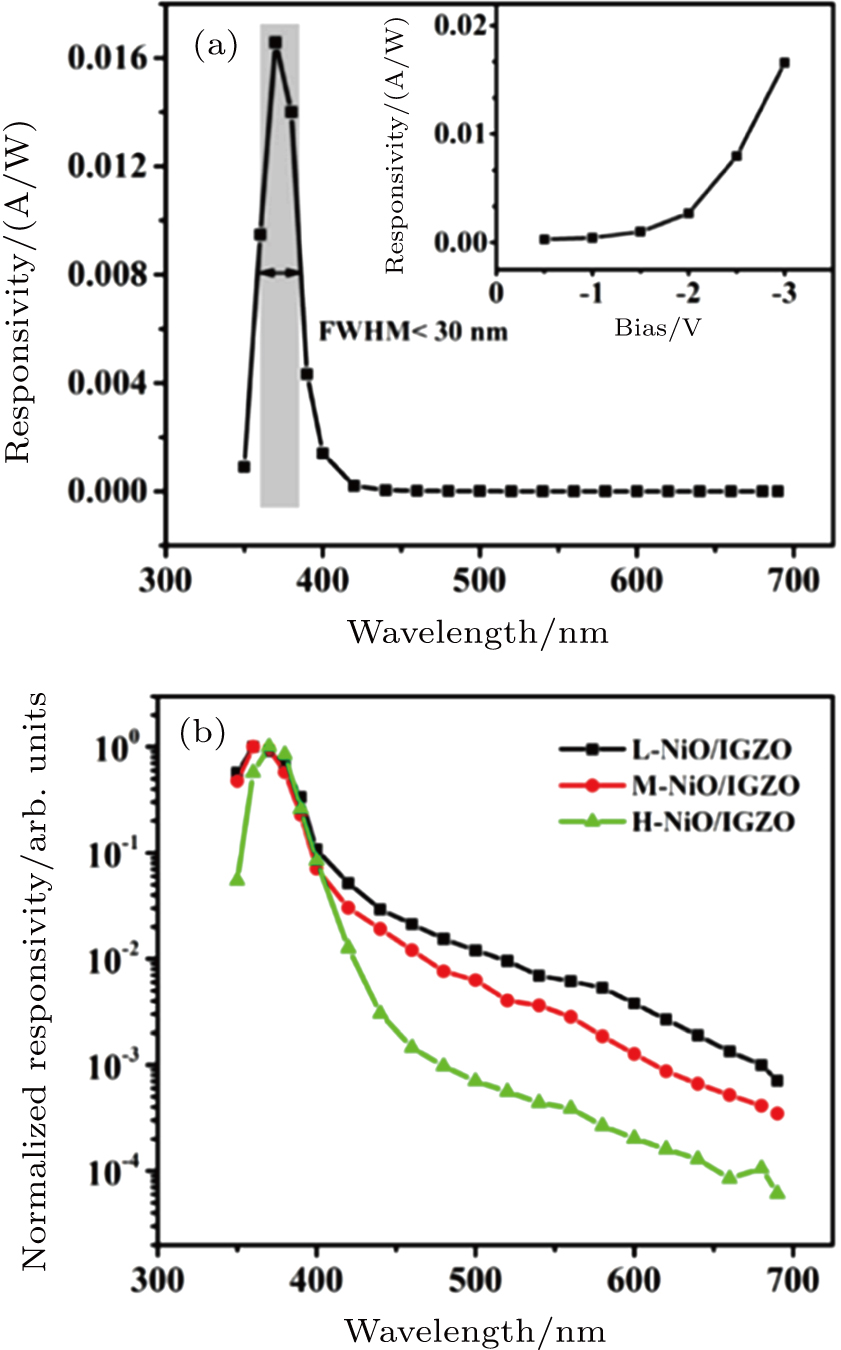 | Fig. 7. (a) Spectral responsivity of the ITO/H-NiO (high conductivity NiO)/IGZO/ITO photodetector under the bias of −3 V. The inset shows the responsivity as a function of the reverse bias. (b) Normalized spectral responsivities of the ITO/L–NiO (low conductivity NiO)/IGZO/ITO, ITO/M–NiO (medium conductivity NiO)/IGZO/ITO, and ITO/H–NiO/IGZO/ITO photodetector structures at -3-V bias.[138] |
Tsai et al.[139] fabricated p-NiO/n-ZnO by RF magnetron sputtering on glass substrate. The current–voltage curve of the heterojunction demonstrated obvious rectifying diode behavior in a dark environment. The lowest leakage current was 7.73×10−8 A/cm2 for n-ZnO/p-NiO heterojunction diode. In 2017, Patel et al.[140] realized the high transparent self-powered heterojunction photodetector of the configuration of NiO/ZnO/ITO/polyethylene terephthalate (PET) by using the solid-state sputtering method. This high visible-range transparent (74.8%) photodetector was extremely sensitive to the tiny UV light density.
This review has introduced ultraviolet photodetectors based on wide bandgap oxide semiconductor films, including ZnO, ZnMgO, Ga2O3, TiO2, and NiO. The growth method of the materials, the classification of the photodetectors, and the development of performance of the devices have been reviewed and summarized. Recent progresses and challenges in this field are systematically discussed. Systematic comparison of photodetector performances based on these devices has been summarized in Table
| Table 1.
Comparison of the photodetector performances for wide bandgap oxide photodetector. . |
| [1] | |
| [2] | |
| [3] | |
| [4] | |
| [5] | |
| [6] | |
| [7] | |
| [8] | |
| [9] | |
| [10] | |
| [11] | |
| [12] | |
| [13] | |
| [14] | |
| [15] | |
| [16] | |
| [17] | |
| [18] | |
| [19] | |
| [20] | |
| [21] | |
| [22] | |
| [23] | |
| [24] | |
| [25] | |
| [26] | |
| [27] | |
| [28] | |
| [29] | |
| [30] | |
| [31] | |
| [32] | |
| [33] | |
| [34] | |
| [35] | |
| [36] | |
| [37] | |
| [38] | |
| [39] | |
| [40] | |
| [41] | |
| [42] | |
| [43] | |
| [44] | |
| [45] | |
| [46] | |
| [47] | |
| [48] | |
| [49] | |
| [50] | |
| [51] | |
| [52] | |
| [53] | |
| [54] | |
| [55] | |
| [56] | |
| [57] | |
| [58] | |
| [59] | |
| [60] | |
| [61] | |
| [62] | |
| [63] | |
| [64] | |
| [65] | |
| [66] | |
| [67] | |
| [68] | |
| [69] | |
| [70] | |
| [71] | |
| [72] | |
| [73] | |
| [74] | |
| [75] | |
| [76] | |
| [77] | |
| [78] | |
| [79] | |
| [80] | |
| [81] | |
| [82] | |
| [83] | |
| [84] | |
| [85] | |
| [86] | |
| [87] | |
| [88] | |
| [89] | |
| [90] | |
| [91] | |
| [92] | |
| [93] | |
| [94] | |
| [95] | |
| [96] | |
| [97] | |
| [98] | |
| [99] | |
| [100] | |
| [101] | |
| [102] | |
| [103] | |
| [104] | |
| [105] | |
| [106] | |
| [107] | |
| [108] | |
| [109] | |
| [110] | |
| [111] | |
| [112] | |
| [113] | |
| [114] | |
| [115] | |
| [116] | |
| [117] | |
| [118] | |
| [119] | |
| [120] | |
| [121] | |
| [122] | |
| [123] | |
| [124] | |
| [125] | |
| [126] | |
| [127] | |
| [128] | |
| [129] | |
| [130] | |
| [131] | |
| [132] | |
| [133] | |
| [134] | |
| [135] | |
| [136] | |
| [137] | |
| [138] | |
| [139] | |
| [140] |

